

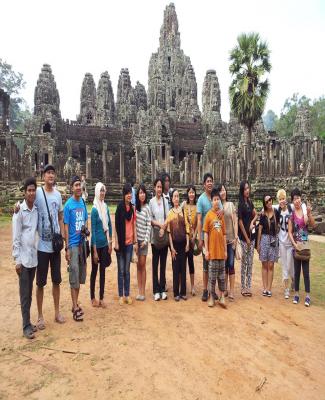

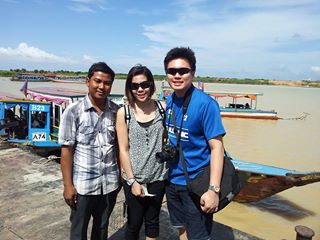
.jpg)




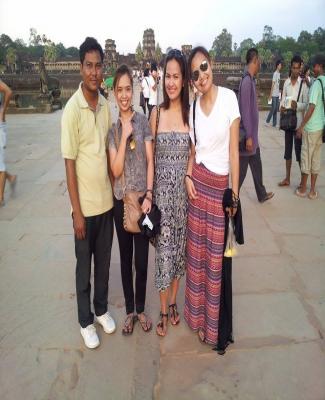


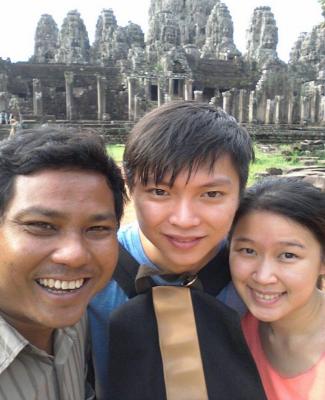


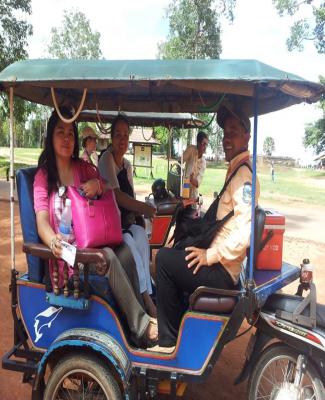



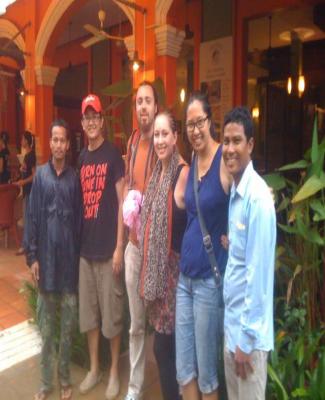





Preah Vihear Temple (a World Heritage Site) in Cambodia
Preah Vihear Temple (Khmer: ប្រាសាទព្រះវិហារ) is a Hindu temple built during the reign of Khmer Empire, that is situated atop a 525-metre (1,722 ft) cliff in the Dângrêk Mountains, in the Preah Vihear province, Cambodia. In 1962, following a lengthy dispute between Thailand and Cambodia over ownership, the International Court of Justice (ICJ) in The Hague awarded the temple to Cambodia. Affording a view for many kilometers across a plain, Prasat Preah Vihear has the most spectacular setting of all the temples built during the six-centuries-long Khmer Empire. As a key edifice of the empire's spiritual life, it was supported and modified by successive kings and so bears elements of several architectural styles. Preah Vihear is unusual among Khmer temples in being constructed along a long north-south axis, rather than having the conventional rectangular plan with orientation toward the east. The temple gives its name to Cambodia's Preah Vihear province, in which it is now located, as well as the Khao Phra Wihan National Park which borders it in Thailand's Sisaket province and through which the temple is most easily accessible. On July 7, 2008, Preah Vihear was listed as a UNESCO World Heritage Site. On July 8, 2008, the World Heritage Committee decided to add Prasat Preah Vihear, along with 26 other sites, to the World Heritage Site list, despite several protests from Thailand, since the map implied Cambodian ownership of disputed land next to the temple. As the process of Heritage-listing began, Cambodia announced its intention to apply for World Heritage inscription by UNESCO. Thailand protested that it should be a joint-effort and UNESCO deferred debate at its 2007 meeting. Following this, both Cambodia and Thailand were in full agreement that Preah Vihear Temple had "Outstanding Universal Value" and should be inscribed on theWorld Heritage List as soon as possible. The two nations agreed that Cambodia should propose the site for formal inscription on the World Heritage List at the 32nd session of the World Heritage Committee in 2008 with the active support of Thailand. This led to a redrawing of the map of the area for proposed inscription, leaving only the temple and its immediate environs. However, Thailand's political opposition launched an attack on this revised plan (see Modern History and Ownership Dispute), claiming the inclusion of Preah Vihear could nevertheless "consume" the overlapping disputed area near the temple. In response to the political pressure at home, the Thai government withdrew its formal support for the listing of Preah Vihear Temple as a World Heritage site. Cambodia continued with the application for World Heritage status and, despite official Thai protests, on July 7, 2008, Preah Vihear Temple was inscribed on the list of World Heritage sites. The renewed national boundary dispute since 2008 has been a reminder that despite the World Heritage ideals of conservation for all humanity, operating a World Heritage site often requires use of national authority at odds with the local cultures and natural diversity of the landscape. Prior to the listing, Cambodia considered Preah Vihear to be part of a Protected Landscape (IUCN category V), defined as "Nationally significant natural and semi-natural landscapes which must be maintained to provide opportunities for recreation." However, Category V is generally defined as "Land, with coast and seas as appropriate, where the interaction of people and nature over time has produced an area of distinct character with significant aesthetic, cultural and/or ecological value, and often with high biological diversity. Safeguarding the integrity of this traditional interaction is vital to the protection, maintenance and evolution of such an area." During the People's Alliance for Democracy's seizure of Suvarnabhumi Airport, future Thai Foreign Minister Kasit Piromya reportedly called Cambodian Prime Minister in a 2008 television interview "crazy" and a "nak leng" (commonly translated as "gangster"). In 1994, Thailand held a World Heritage proposal conference in Srisaket in which local cultural traditions were considered along with monuments such as Preah Vihear that stimulate more nationalistic sentiments. The use of passes in the Dongrak Mountains reportedly tied together cultural communities and practices divided by a militarized (and imperfectly demarcated) modern border line. A Mon-Khmer ethnic minority, the Kui or Suay (the ethnonyms have multiple spellings), used the passes to hunt and capture elephants in the forests below the Dongrak cliff edge, including the Kulen area which is now a Cambodian wildlife sanctuary. Kui in Cambodia were skilled ironsmiths using ore from Phnom Dek. While elephant hunting in the vicinity of Preah Vihear was touched upon in the International Court of Justice proceedings, the World Heritage plans overlook local culture and species protection to facilitate national revenues from tourism. One international law professor has urged that practicality calls for laying aside exclusive sovereignty in favor of an "international peace park. A scholarly article concurs in concluding: "Since Thailand and Cambodia have brought only blood and bitterness to this place, it might be desirable to preserve it from both. It could be given back to nature and the indigenous peoples, to be managed cooperatively between the two governments in equal partnership with local communities, as a transborder Protected Landscape-Anthropological Reserve (IUCN category V and old category VII). Given the massing troops in 2008, perhaps such a transborder reserve would create not only a demilitarized buffer zone in which any future demarcation can be amicably undertaken, but a recognition of the added ecological and cultural aspects of an area which both Cambodia and Thailand may still save from the destructive and exploitative impacts of rapid development so often suffered in other ASEAN countries. |
Recently Guest Booking:
Guest Name: Jaxon Hepp
Country: Italy
City: Castel Dell'alpi
Travel Date:
Arrival By: Other
Tour Name: Special Angkor Tour 3 Days Option 2 (3days with Tuk Tuk Driver)


